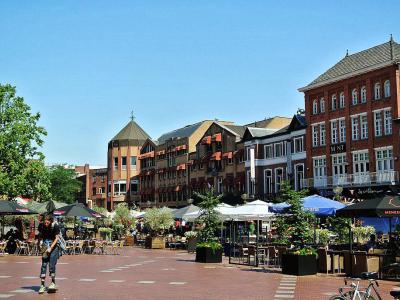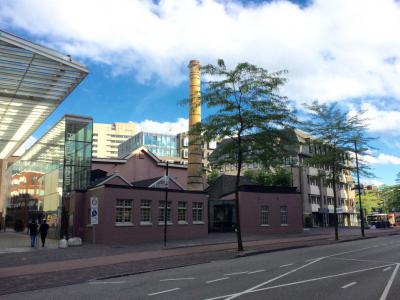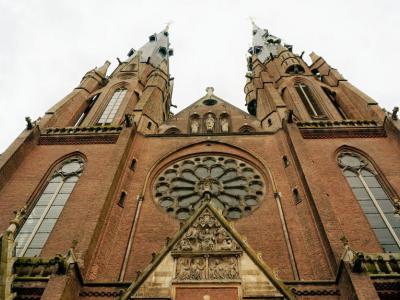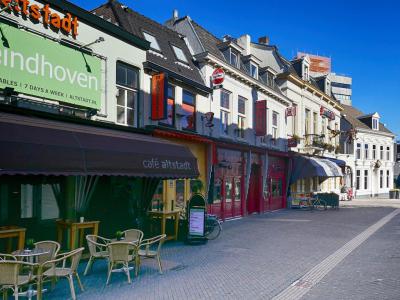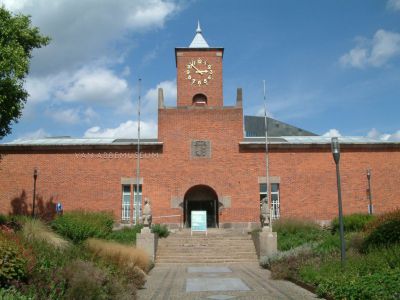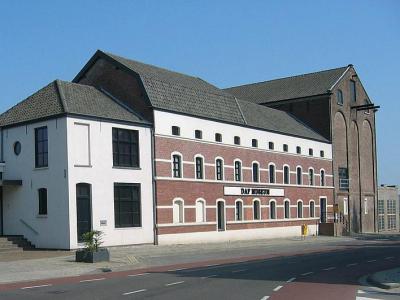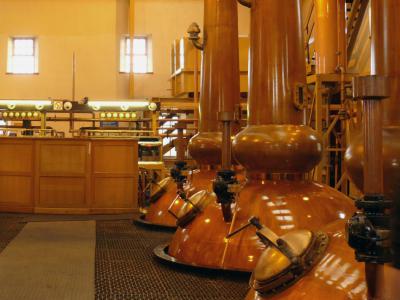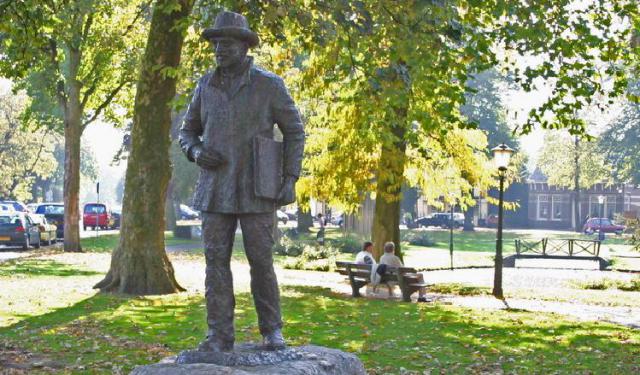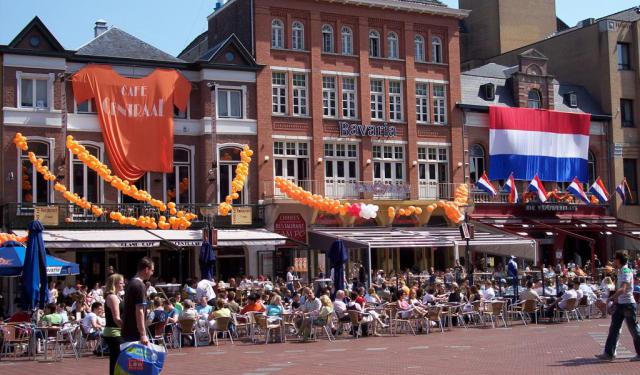
Eindhoven Introduction Walking Tour (Self Guided), Eindhoven
Eindhoven is the largest city in the province of North Brabant in the Netherlands. It was founded in the 13th century but didn't see large growth until DAF Trucks and Philips Electronics were established in the city during the 19th and 20th centuries.
Eindhoven was officially given status as a municipality in 1232. It was already a small town with less than 200 houses inside the city walls. The municipal status gave it the right to hold a weekly market in Market Square.
Buildings from the early days of Eindhoven were largely destroyed in the fire of 1554. Due to repeat disputes over land, many of the rebuilt structures were damaged throughout the years. Spain and France both vied for control over the area even after it became part of the Netherlands in 1629.
Philips Electronics played a prominent role in the advancement of Eindhoven. Founded in 1891 to manufacture light bulbs, Philips became a primary employer in the city. As the company expanded its presence around the globe, Eindhoven became firmly established as an industrial center. DAF Trucks was another industrial powerhouse that brought jobs and wealth to the community. Tourists can experience the history of these two companies by visiting the Philips Museum and the DAF Museum.
World War II caused a great deal of damage to Eindhoven. The Philips factory, located in downtown Eindhoven, was targeted by air raids. This left much of the city in ruins. The reconstruction that came after the war replaced traditional structures with modern ones.
Some historical buildings manage to survive. A prime example is Saint Catherine's Church, a Neo-Gothic church built in 1867. Visitors can also see important buildings and monuments along Stratumseind and Market Square.
A stone's throw from Eindhoven is the small village of Nuenen, where the world-famous impression painter, Vincent Van Gogh, spent a few years of his life there. The artist loved the surroundings and the people, and Nuenen became the inspiration behind many of Van Gogh's works. He even found his love there. Today, Van Gogh's former studio and residence draw admirers to the artist in large numbers.
Take this self-guided walking tour to learn more about the beautiful city of Eindhoven.
Eindhoven was officially given status as a municipality in 1232. It was already a small town with less than 200 houses inside the city walls. The municipal status gave it the right to hold a weekly market in Market Square.
Buildings from the early days of Eindhoven were largely destroyed in the fire of 1554. Due to repeat disputes over land, many of the rebuilt structures were damaged throughout the years. Spain and France both vied for control over the area even after it became part of the Netherlands in 1629.
Philips Electronics played a prominent role in the advancement of Eindhoven. Founded in 1891 to manufacture light bulbs, Philips became a primary employer in the city. As the company expanded its presence around the globe, Eindhoven became firmly established as an industrial center. DAF Trucks was another industrial powerhouse that brought jobs and wealth to the community. Tourists can experience the history of these two companies by visiting the Philips Museum and the DAF Museum.
World War II caused a great deal of damage to Eindhoven. The Philips factory, located in downtown Eindhoven, was targeted by air raids. This left much of the city in ruins. The reconstruction that came after the war replaced traditional structures with modern ones.
Some historical buildings manage to survive. A prime example is Saint Catherine's Church, a Neo-Gothic church built in 1867. Visitors can also see important buildings and monuments along Stratumseind and Market Square.
A stone's throw from Eindhoven is the small village of Nuenen, where the world-famous impression painter, Vincent Van Gogh, spent a few years of his life there. The artist loved the surroundings and the people, and Nuenen became the inspiration behind many of Van Gogh's works. He even found his love there. Today, Van Gogh's former studio and residence draw admirers to the artist in large numbers.
Take this self-guided walking tour to learn more about the beautiful city of Eindhoven.
How it works: Download the app "GPSmyCity: Walks in 1K+ Cities" from Apple App Store or Google Play Store to your mobile phone or tablet. The app turns your mobile device into a personal tour guide and its built-in GPS navigation functions guide you from one tour stop to next. The app works offline, so no data plan is needed when traveling abroad.
Eindhoven Introduction Walking Tour Map
Guide Name: Eindhoven Introduction Walking Tour
Guide Location: Netherlands » Eindhoven (See other walking tours in Eindhoven)
Guide Type: Self-guided Walking Tour (Sightseeing)
# of Attractions: 7
Tour Duration: 2 Hour(s)
Travel Distance: 2.8 Km or 1.7 Miles
Author: Cathy
Sight(s) Featured in This Guide:
Guide Location: Netherlands » Eindhoven (See other walking tours in Eindhoven)
Guide Type: Self-guided Walking Tour (Sightseeing)
# of Attractions: 7
Tour Duration: 2 Hour(s)
Travel Distance: 2.8 Km or 1.7 Miles
Author: Cathy
Sight(s) Featured in This Guide:
- Market Square
- Philips Museum
- Saint Catherine's Church (St. Catharinakerk)
- Stratumseind
- Van Abbemuseum
- DAF Museum
- Bottle Distillery
1) Market Square
Market Square in Eindhoven, referred to as Markt, is a public square surrounded by cozy restaurants, cafes, and pubs. It has been operating since 1232, when it was a marketplace. The area still serves as an antique market on Saturdays. Visitors can also find clothing, jewelry, and souvenirs for sale in the market.
Market Square is primarily known as a central meeting square for the various shops and restaurants in its vicinity. Tourists will find the Heuvel Galerie mall for shopping, a branch of the Holland Casino, and a selection of cafes.
Well-lit, ornate, and with inviting melodies, the Merry-Go-Round is also located in the square. Among several works of art housed in the Market Square, visitors should look for statues of famous Eindhoven residents Jan van Hooff and Frits Philips, crafted by Auke Hettema and Kees Verkade, respectively.
Many old buildings that once dominated the square were removed. Those that are still in place have mostly been repurposed. Nr. 1 Market Street was once a bank building but now holds a fast-food restaurant. Numbers 9, 10, and 11 are now part of the Heuvel Galerie shopping center.
Market Square is primarily known as a central meeting square for the various shops and restaurants in its vicinity. Tourists will find the Heuvel Galerie mall for shopping, a branch of the Holland Casino, and a selection of cafes.
Well-lit, ornate, and with inviting melodies, the Merry-Go-Round is also located in the square. Among several works of art housed in the Market Square, visitors should look for statues of famous Eindhoven residents Jan van Hooff and Frits Philips, crafted by Auke Hettema and Kees Verkade, respectively.
Many old buildings that once dominated the square were removed. Those that are still in place have mostly been repurposed. Nr. 1 Market Street was once a bank building but now holds a fast-food restaurant. Numbers 9, 10, and 11 are now part of the Heuvel Galerie shopping center.
2) Philips Museum (must see)
Philips Museum details the history of the Philips electronic company. The museum, established in 2013, is held in the original Philips factory.
The museum building is a national monument constructed in 1888. The building's first purpose was the manufacturing of incandescent light bulbs.
Visitors to the Philips Museum will see permanent exhibitions along with rotating displays. The permanent exhibitions show the evolution of the light bulb, from a dimly-lit room with only candlelight to an area that mimics a lamp factory.
Several historic lamps can be seen at the Philips Museum. Patrons will find incandescent lamps, fluorescent lamps, sodium lamps, and LED lamps.
The museum also displays medical devices like X-rays, CT equipment, and MRI scanners. The Philips factory began producing medical equipment in 1918. Other items on display include radios, televisions, kitchen appliances, and electric shavers.
Philips Museum has a permanent exhibit called "Innovation & You." This interactive exhibit shows the future of healthcare. Visitors of all ages can watch themselves through infrared monitors and compare their health statistics to other museum visitors.
Another permanent exhibit is called "Philips Eyecatchers." This exhibition shows artwork from early advertising designed by famous artists like Louis Kalff, Mathieu Clement, Albert Hahn, and Paul Schuitema.
Visitors will find more than displays at the Philips Museum. They will also enjoy a cafe with pastries and juices made from the fruit grown in the Philips Orchard and a gift shop with souvenirs.
Philips Museum is open Tuesday through Sunday from 11 AM to 5 PM. The museum closes for bank holidays and once yearly for regular maintenance.
The museum building is a national monument constructed in 1888. The building's first purpose was the manufacturing of incandescent light bulbs.
Visitors to the Philips Museum will see permanent exhibitions along with rotating displays. The permanent exhibitions show the evolution of the light bulb, from a dimly-lit room with only candlelight to an area that mimics a lamp factory.
Several historic lamps can be seen at the Philips Museum. Patrons will find incandescent lamps, fluorescent lamps, sodium lamps, and LED lamps.
The museum also displays medical devices like X-rays, CT equipment, and MRI scanners. The Philips factory began producing medical equipment in 1918. Other items on display include radios, televisions, kitchen appliances, and electric shavers.
Philips Museum has a permanent exhibit called "Innovation & You." This interactive exhibit shows the future of healthcare. Visitors of all ages can watch themselves through infrared monitors and compare their health statistics to other museum visitors.
Another permanent exhibit is called "Philips Eyecatchers." This exhibition shows artwork from early advertising designed by famous artists like Louis Kalff, Mathieu Clement, Albert Hahn, and Paul Schuitema.
Visitors will find more than displays at the Philips Museum. They will also enjoy a cafe with pastries and juices made from the fruit grown in the Philips Orchard and a gift shop with souvenirs.
Philips Museum is open Tuesday through Sunday from 11 AM to 5 PM. The museum closes for bank holidays and once yearly for regular maintenance.
3) Saint Catherine's Church (St. Catharinakerk) (must see)
Saint Catherine's Church is a Roman Catholic church in the downtown area of Eindhoven. Dedicated to Saint Catherine of Alexandria, it was built on the site of a medieval church known as Saint Katarina.
The original church was constructed sometime in the 13th century but was not well established until 1340. A cemetery was built near the church in 1399 after it was promoted from a dependent to a collegiate church. The church also became known as a place of pilgrimage.
Sadly, the original church faced much destruction throughout its life. Partially damaged by fire in 1554, it was looted, fell into ruin, and eventually razed.
The current Saint Catherine's Church was built in 1867. It was designed in the Gothic Revival architectural style by architect Pierre Cuypers. For this church, Cuypers used ideas of symbolism in designing two towers. The southern tower is the more refined and represents the Ivory Tower, a symbol of the purity of Mary. The northern structure, decorated with turrets and battlements, represents the Tower of David, a symbol of strength.
Saint Catherine's Church was damaged during World War II. Restoration work replaced glass windows with stained glass crafted by Charles Eyck and Pieter Wiegersma. The largest of the church's two organs was destroyed in the war and rebuilt with more than 5,700 pipes. A carillon with a circumference of five octaves was added in 1966.
The Music Foundation regularly holds music concerts in the church. The church building was declared a National Cultural Monument in 1972.
The original church was constructed sometime in the 13th century but was not well established until 1340. A cemetery was built near the church in 1399 after it was promoted from a dependent to a collegiate church. The church also became known as a place of pilgrimage.
Sadly, the original church faced much destruction throughout its life. Partially damaged by fire in 1554, it was looted, fell into ruin, and eventually razed.
The current Saint Catherine's Church was built in 1867. It was designed in the Gothic Revival architectural style by architect Pierre Cuypers. For this church, Cuypers used ideas of symbolism in designing two towers. The southern tower is the more refined and represents the Ivory Tower, a symbol of the purity of Mary. The northern structure, decorated with turrets and battlements, represents the Tower of David, a symbol of strength.
Saint Catherine's Church was damaged during World War II. Restoration work replaced glass windows with stained glass crafted by Charles Eyck and Pieter Wiegersma. The largest of the church's two organs was destroyed in the war and rebuilt with more than 5,700 pipes. A carillon with a circumference of five octaves was added in 1966.
The Music Foundation regularly holds music concerts in the church. The church building was declared a National Cultural Monument in 1972.
4) Stratumseind
Stratumseind is a 738-foot street between Saint Catherine's Church and the Dommel Bridge. The historic street is now bustling with numerous shops, cafes, clubs, bars, and a booming nightlife.
The street wasn't always a place for fun and entertainment. Before the 20th century, it was home to industries like tanners and cigar manufacturers. There were also butchers, bakers, hairdressers, and haberdasheries along the street. A few cafes could be found on Stratumseind until the late 20th century when drinks and dining became the primary business.
Stratumseind is a modern street, but there are still several old buildings lining the street. Stratumseind 17-19, directly across from Saint Catherine's Church, are 300-year-old buildings that now host a cafe and bar. Stratumseind 32, built in 1843, was once a courthouse. Stratumseind 42 and 71 were built in the 16th century and beautifully restored.
The statue "The Temptation, the Wisdom and the Danger" by sculptor Henck van Dijck can be found where Stratumseind meets Oude Stadsgracht (Old City Canal ). The sculpture, crafted in 1995, is made from bronze, acrylic, concrete, and LED lights.
The street wasn't always a place for fun and entertainment. Before the 20th century, it was home to industries like tanners and cigar manufacturers. There were also butchers, bakers, hairdressers, and haberdasheries along the street. A few cafes could be found on Stratumseind until the late 20th century when drinks and dining became the primary business.
Stratumseind is a modern street, but there are still several old buildings lining the street. Stratumseind 17-19, directly across from Saint Catherine's Church, are 300-year-old buildings that now host a cafe and bar. Stratumseind 32, built in 1843, was once a courthouse. Stratumseind 42 and 71 were built in the 16th century and beautifully restored.
The statue "The Temptation, the Wisdom and the Danger" by sculptor Henck van Dijck can be found where Stratumseind meets Oude Stadsgracht (Old City Canal ). The sculpture, crafted in 1995, is made from bronze, acrylic, concrete, and LED lights.
5) Van Abbemuseum (must see)
Van Abbemuseum is a museum of modern and contemporary art named after its founder, cigar manufacturer, and private art collector, Henri van Abbe. The museum opened in 1936.
Van Abbe planned the museum to introduce the public to contemporary art. He loaned his extensive collection for display. He also donated today's equivalent of $1.5 million to build the museum and buy more works of art.
The building, designed by architect Alexander Jacobus Kropholler, is constructed in the Traditionalist architectural style. A wing added in 2003 significantly increased the size of the museum. The new wing was designed by Abel Cahen on the exterior and by Maarten van Severen on the interior.
Van Abbemuseum has more than 2,700 works of art. Pieces include sculptures, drawings, paintings, installations, and videos. It has one of the world's largest art collections by El Lissitzky, a Russian artist, designer, photographer, and architect. Other artists featured at the museum include Pablo Piccaso, Marc Chagall, Piet Mondrian, Theo van Doesburg, and Wassily Kandinsky. Auguste Rodin’s statue of Honoré de Balzac, bought by the city of Eindhoven in 1965, has stood in the garden of the Van Abbemuseum.
Van Abbe planned the museum to introduce the public to contemporary art. He loaned his extensive collection for display. He also donated today's equivalent of $1.5 million to build the museum and buy more works of art.
The building, designed by architect Alexander Jacobus Kropholler, is constructed in the Traditionalist architectural style. A wing added in 2003 significantly increased the size of the museum. The new wing was designed by Abel Cahen on the exterior and by Maarten van Severen on the interior.
Van Abbemuseum has more than 2,700 works of art. Pieces include sculptures, drawings, paintings, installations, and videos. It has one of the world's largest art collections by El Lissitzky, a Russian artist, designer, photographer, and architect. Other artists featured at the museum include Pablo Piccaso, Marc Chagall, Piet Mondrian, Theo van Doesburg, and Wassily Kandinsky. Auguste Rodin’s statue of Honoré de Balzac, bought by the city of Eindhoven in 1965, has stood in the garden of the Van Abbemuseum.
6) DAF Museum (must see)
DAF Museum is an automotive museum and national monument. It pays homage to DAF or Van Doorne's Automotive Factory, founded by two brothers, Hubert Jozef and Willem van Doorne. It is one of only two certified automotive museums in the Netherlands.
The museum building was constructed in 1884 as a steam beer brewery called De Valk. It was the largest brewery in Eindhoven at the time it was built. Later, the building housed a company that made ice bars for cooling beer. Once the company closed, the DAF museum was established.
The museum exhibits DAF vehicles, including prototypes for some cars that were never produced. There are numerous sports cars, vans, buses, army trucks, and fire engines. The museum hosts a tow truck and a concrete mixer.
The museum also offers a history of the DAF passenger car and the company itself. The Paccar Wing displays engines developed to meet new environmental standards. Rotating exhibits are showcased in the Paccar Wing. These change about once per year.
The Trucknasium teaches children about vehicles, road safety, and the environment with interactive exhibits. Older children can even take classes on traffic safety or learn about how automobiles are designed and manufactured.
The Forge shows a reproduction of the first DAF workshop. The Hans Staal Halls of History gives patrons a tour of the company's impact on history. There is also a components gallery and a showcase of DAF miniatures and trinkets.
The DAF Museum is open Tuesday to Saturday from 10 AM to 5 PM.
The museum building was constructed in 1884 as a steam beer brewery called De Valk. It was the largest brewery in Eindhoven at the time it was built. Later, the building housed a company that made ice bars for cooling beer. Once the company closed, the DAF museum was established.
The museum exhibits DAF vehicles, including prototypes for some cars that were never produced. There are numerous sports cars, vans, buses, army trucks, and fire engines. The museum hosts a tow truck and a concrete mixer.
The museum also offers a history of the DAF passenger car and the company itself. The Paccar Wing displays engines developed to meet new environmental standards. Rotating exhibits are showcased in the Paccar Wing. These change about once per year.
The Trucknasium teaches children about vehicles, road safety, and the environment with interactive exhibits. Older children can even take classes on traffic safety or learn about how automobiles are designed and manufactured.
The Forge shows a reproduction of the first DAF workshop. The Hans Staal Halls of History gives patrons a tour of the company's impact on history. There is also a components gallery and a showcase of DAF miniatures and trinkets.
The DAF Museum is open Tuesday to Saturday from 10 AM to 5 PM.
7) Bottle Distillery (must see)
Bottle Distillery is a distillery for spirits like gin, rum, vodka, beer, brandy, and liqueurs. The distillery is open to the public for tours, tastings, and workshops.
The distillery is located in De Caai, the former Campina site, one of the dairy facilities in the Netherlands. The dairy factory collected milk from farmers, which was then distributed. Today, De Caai hosts some businesses and residential areas. Bottle Distillery is arguably the most notable.
Those who wish to visit Bottle Distillery must choose from a tour, tasting, or class. A 30-minute guided tour includes information about the distillery and some of the spirits. Three tastings are included with the guided tour.
Tastings are 90-minute tours with in-depth information about the spirits made at the distillery. Visitors can try an assortment of liquors and beers.
Each workshop last 2.5 hours. Attendees can choose from gin or rum classes. These workshops include tours and comprehensive information about making the chosen spirit. Visitors will then flavor their rum or gin, which they can take out at the end of the class.
The distillery is located in De Caai, the former Campina site, one of the dairy facilities in the Netherlands. The dairy factory collected milk from farmers, which was then distributed. Today, De Caai hosts some businesses and residential areas. Bottle Distillery is arguably the most notable.
Those who wish to visit Bottle Distillery must choose from a tour, tasting, or class. A 30-minute guided tour includes information about the distillery and some of the spirits. Three tastings are included with the guided tour.
Tastings are 90-minute tours with in-depth information about the spirits made at the distillery. Visitors can try an assortment of liquors and beers.
Each workshop last 2.5 hours. Attendees can choose from gin or rum classes. These workshops include tours and comprehensive information about making the chosen spirit. Visitors will then flavor their rum or gin, which they can take out at the end of the class.
Walking Tours in Eindhoven, Netherlands
Create Your Own Walk in Eindhoven
Creating your own self-guided walk in Eindhoven is easy and fun. Choose the city attractions that you want to see and a walk route map will be created just for you. You can even set your hotel as the start point of the walk.
Van Gogh's Nuenen Walking Tour
The small town of Nuenen, located practically a stone's throw from Eindhoven, is a very old Dutch locality that shot into significance as the inspiration behind many of the works by Vincent van Gogh. The painter lived and worked here for 18 months, from December 1883 to May 1885. During this period he created many paintings capturing the images of local people (peasants, weavers, etc.) such... view more
Tour Duration: 1 Hour(s)
Travel Distance: 1.3 Km or 0.8 Miles
Tour Duration: 1 Hour(s)
Travel Distance: 1.3 Km or 0.8 Miles
The Most Popular Cities
/ view all
